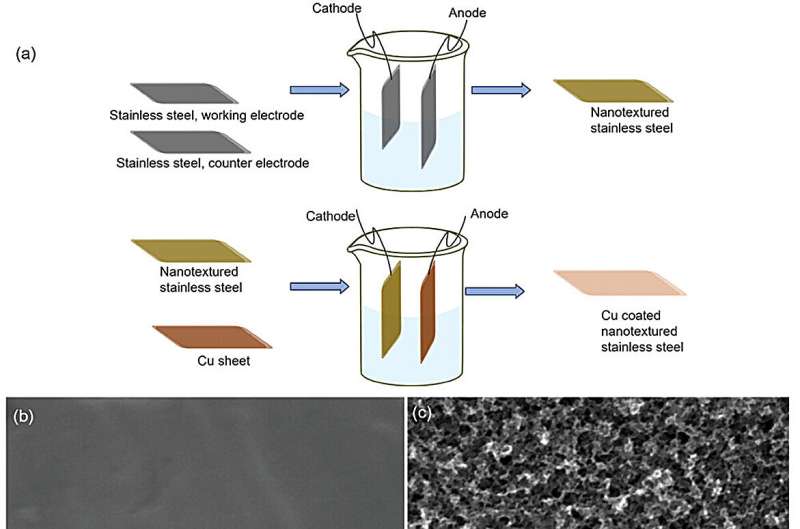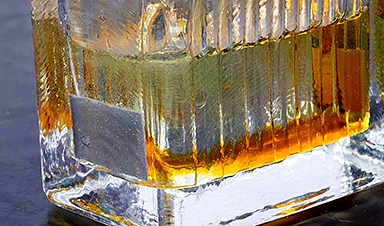An electrochemical process developed at Georgia Tech could offer new protection against bacterial infections without contributing to growing antibiotic resistance.
The approach capitalizes on the natural antibacterial properties of copper and creates incredibly small needle-like structures on the surface of stainless steel to kill harmful bacteria like E. coli and Staphylococcus. It’s convenient and inexpensive, and it could reduce the need for chemicals and antibiotics in hospitals, kitchens, and other settings where surface contamination can lead to serious illness.
It also could save lives: A global study of drug-resistant infections found they directly killed 1.27 million people in 2019 and contributed to nearly 5 million other deaths—making these infections one of the leading causes of death for every age group.
Researchers described the copper-stainless steel and its effectiveness May 20 in the journal Small.
“Killing Gram-positive bacteria without chemicals is comparatively easy but tackling Gram-negative bacteria poses a significant challenge, due to their thick, multilayered cell membrane. And if these bacteria persist on surfaces, they can grow rapidly,” said Anuja Tripathi, the study’s lead author and a postdoctoral scholar in the School of Chemical and Biomolecular Engineering. “I aimed to develop an antibiotic-free bactericidal surface effective against Gram-negative and Gram-positive bacteria.”
Tripathi and her colleagues—William R. McLain Professor Julie Champion and former Ph.D. students Jaeyoung Park and Thomas Pho—produced a one-two punch that overcomes those challenges and doesn’t help bacteria develop resistance to drugs.
The team first developed an electrochemical method to etch the surface of stainless steel, creating nano-sized needle-like structures on the surface that can puncture bacteria’s cell membranes. Then, with a second electrochemical process, the researchers deposited copper ions on the steel’s surface.
Copper interacts with the cell membranes and ultimately compromises them.
“The nanotextured stainless steel can kill both Gram-negative and Gram-positive bacteria, but we wanted to enhance the antibacterial activity for surfaces that can be highly contaminated,” Tripathi said. “The copper coating on the nanotextured stainless steel gave us very high antibacterial activity.”

and c,e) nanotextured stainless steel etched for 30 s at 8 V. Credit: Small (2024). DOI: 10.1002/smll.202311546
Despite copper’s known antibacterial properties, it’s not widely used to fight surface contamination because it’s expensive. Tripathi’s approach deposits only a thin layer of copper ions on the stainless steel, so it’s cost-effective without compromising the material’s antibacterial activity.
Together, the dual attacks resulted in 97% reduction of Gram-negative E. coli and 99% reduction in Gram-positive Staphylococcus epidermis bacteria in the group’s study.
Tripathi said the stainless steel could be used for common tools in medical settings that are easily fouled, such as scissors or tweezers. It could be used for door handles, stair railings, and perhaps even sinks—places where stainless steel is often the material of choice and surface bacteria are common, especially in hospitals or other shared settings.
The process she and her colleagues developed also could be useful in food service. Tripathi said the approach could be fairly easily incorporated into existing industrial processes, where different electrochemical coating methods already are used for stainless steel food storage containers.
Tripathi said future work will investigate if the copper-coated, nanotextured stainless steel is effective against other kinds of cells harmful to human health. She’s also interested in exploring whether the steel could be used for medical implants to help ward off infections.
Since it proved effective against troublesome E. coli, she’s hopeful.
“Reflecting on a recent E. coli outbreak in grocery stores in Calgary, Canada, I was particularly driven in my research, recognizing the urgent relevance and significance of combating such resilient bacteria on surfaces,” Tripathi said. “They can be difficult to eliminate. So, if we can effectively eliminate E. coli, we stand a good chance of eradicating many bacteria on surfaces.”
More information: Anuja Tripathi et al, Dual Antibacterial Properties of Copper‐Coated Nanotextured Stainless Steel, Small (2024). DOI: 10.1002/smll.202311546
Journal information: Small
Provided by Georgia Institute of Technology
News
Studies detail high rates of long COVID among healthcare, dental workers
Researchers have estimated approximately 8% of Americas have ever experienced long COVID, or lasting symptoms, following an acute COVID-19 infection. Now two recent international studies suggest that the percentage is much higher among healthcare workers [...]
Melting Arctic Ice May Unleash Ancient Deadly Diseases, Scientists Warn
Melting Arctic ice increases human and animal interactions, raising the risk of infectious disease spread. Researchers urge early intervention and surveillance. Climate change is opening new pathways for the spread of infectious diseases such [...]
Scientists May Have Found a Secret Weapon To Stop Pancreatic Cancer Before It Starts
Researchers at Cold Spring Harbor Laboratory have found that blocking the FGFR2 and EGFR genes can stop early-stage pancreatic cancer from progressing, offering a promising path toward prevention. Pancreatic cancer is expected to become [...]
Breakthrough Drug Restores Vision: Researchers Successfully Reverse Retinal Damage
Blocking the PROX1 protein allowed KAIST researchers to regenerate damaged retinas and restore vision in mice. Vision is one of the most important human senses, yet more than 300 million people around the world are at [...]
Differentiating cancerous and healthy cells through motion analysis
Researchers from Tokyo Metropolitan University have found that the motion of unlabeled cells can be used to tell whether they are cancerous or healthy. They observed malignant fibrosarcoma cells and [...]
This Tiny Cellular Gate Could Be the Key to Curing Cancer – And Regrowing Hair
After more than five decades of mystery, scientists have finally unveiled the detailed structure and function of a long-theorized molecular machine in our mitochondria — the mitochondrial pyruvate carrier. This microscopic gatekeeper controls how [...]
Unlocking Vision’s Secrets: Researchers Reveal 3D Structure of Key Eye Protein
Researchers have uncovered the 3D structure of RBP3, a key protein in vision, revealing how it transports retinoids and fatty acids and how its dysfunction may lead to retinal diseases. Proteins play a critical [...]
5 Key Facts About Nanoplastics and How They Affect the Human Body
Nanoplastics are typically defined as plastic particles smaller than 1000 nanometers. These particles are increasingly being detected in human tissues: they can bypass biological barriers, accumulate in organs, and may influence health in ways [...]
Measles Is Back: Doctors Warn of Dangerous Surge Across the U.S.
Parents are encouraged to contact their pediatrician if their child has been exposed to measles or is showing symptoms. Pediatric infectious disease experts are emphasizing the critical importance of measles vaccination, as the highly [...]
AI at the Speed of Light: How Silicon Photonics Are Reinventing Hardware
A cutting-edge AI acceleration platform powered by light rather than electricity could revolutionize how AI is trained and deployed. Using photonic integrated circuits made from advanced III-V semiconductors, researchers have developed a system that vastly [...]
A Grain of Brain, 523 Million Synapses, Most Complicated Neuroscience Experiment Ever Attempted
A team of over 150 scientists has achieved what once seemed impossible: a complete wiring and activity map of a tiny section of a mammalian brain. This feat, part of the MICrONS Project, rivals [...]
The Secret “Radar” Bacteria Use To Outsmart Their Enemies
A chemical radar allows bacteria to sense and eliminate predators. Investigating how microorganisms communicate deepens our understanding of the complex ecological interactions that shape our environment is an area of key focus for the [...]
Psychologists explore ethical issues associated with human-AI relationships
It's becoming increasingly commonplace for people to develop intimate, long-term relationships with artificial intelligence (AI) technologies. At their extreme, people have "married" their AI companions in non-legally binding ceremonies, and at least two people [...]
When You Lose Weight, Where Does It Actually Go?
Most health professionals lack a clear understanding of how body fat is lost, often subscribing to misconceptions like fat converting to energy or muscle. The truth is, fat is actually broken down into carbon [...]
How Everyday Plastics Quietly Turn Into DNA-Damaging Nanoparticles
The same unique structure that makes plastic so versatile also makes it susceptible to breaking down into harmful micro- and nanoscale particles. The world is saturated with trillions of microscopic and nanoscopic plastic particles, some smaller [...]
AI Outperforms Physicians in Real-World Urgent Care Decisions, Study Finds
The study, conducted at the virtual urgent care clinic Cedars-Sinai Connect in LA, compared recommendations given in about 500 visits of adult patients with relatively common symptoms – respiratory, urinary, eye, vaginal and dental. [...]





















